The Relationship Between UX and SEO: Test Your Website
Imagine you are looking for industry information and need answers NOW. You begin your research and are landing on pages that make you say “UGH!’ or “Why isn’t this working?” We’ve all been there before, but have you ever thought about what makes you stay on a page? What gets you past the first impression?
In this post we will:
- Tell you how to avoid SEO mistakes on your B2B website
- Help you keep your website users happy by understanding the relationship between User experience (UX) and SEO
Highlighted factors of the User Interface (UI) that affect the first impression:

The Colors on Your Site
Colors should represent your company’s personality and/or brand and resonate well with your targeted buyer personas. By understanding the psychology of colors, you will be able to know for certain whether blue or purple convey the right message you want to share.
The Fonts Used
As mentioned in the psychology behind type choices infographic, fonts evoke emotions, so fonts on your site should be based on the feeling you want your brand to convey to the audience.
Pictures and Graphics
Images speak louder than words, so make sure you display the best images that represent your company and products. That being said, make sure to check out the video on design tips and tricks to learn about simple tactics you could use to get the best quality images.
Usability
Make it user-friendly. No one likes to land on a site and struggle to navigate through it. Keep things straightforward with having a logical navigation menu and clear calls to action (CTAs).
SmartAcre® Pro Tip: Not sure which style, font, color, or layout is best for your company site? A/B testing behavior patterns on pages to see how your users interact with your site is a great way to find out which works best for your industry.
The SEO Ranking Factors Influenced by UX

Organic Click Through Rate for a Keyword(s)
It is important to align pages and links to the keywords you want to rank for. Pages that are the most relevantly aligned to the keyword and the searcher’s intent gets clicked on more often and those result in more opportunities to make first impressions – impacting both the user experience and your online visibility.
Bounce Rate
Bounce rates occur if a user lands on a page on your site then exits without visiting another page. This sends signals to RankBrain saying that this page isn’t what the user was looking for, and if this happens enough times then your site will drop on the SERP (Search Engine Results Page).
Number of Comments
RankBrain views pages with lots of comments as valuable because it is a clear indication of user engagement and the quality of the page. Not to mention that usually, pages with lots of comments hold nuggets of valuable information with a variety of LSI terms (latent semantic indexing – words or phrases that are semantically related to each other) sprinkled within the on-page content.
Average Time Spent on Page
How long do people spend on your page when coming from the SERP? This is important to know, especially since user time spent on site is directly tied with good UX. The great thing about optimizing for time spent on page is that, if you successfully achieve obtaining a decent organic click-through rate, decreasing your bounce rate, and adding a section for users to leave comments then you have already improved time spent on page.
How UI Affects UX and SEO
As you learned, there are UI factors that must be taken into consideration when designing a website; knowing the mindset, psychology, and behavior patterns of your targeted audience can help you optimize the UI. As for the SEO factors that are influenced by UX, well, they can make or break your website. If you focus all of your attention on the UI design and forget to conduct keyword research, you’re setting yourself up to cast a wide net which can increase your bounce rate (this is a bad thing) as it will pull in large non-targeted audience, which will result in decreasing your rank on the SERP and will make it more difficult for your right buyers to find you.
Optimize UX to Improve SEO
These best practices go hand-in-hand. Without proper website design, site structure, page speed, and on-going testing, you are missing out on SEO opportunities that can set you apart from your competitors. Not to mention when UX and SEO are backed by marketing strategies and technology, you’re set up to create a powerful lead and demand generation engine, making it easier for your sales team to “go get em!”
Keep these UX and SEO best practices in mind to eliminate friction in the buying process and help your audience find the information they need, 24/7. Need a hand figuring out how to evaluate your current opportunities to rank better? Contact us!

